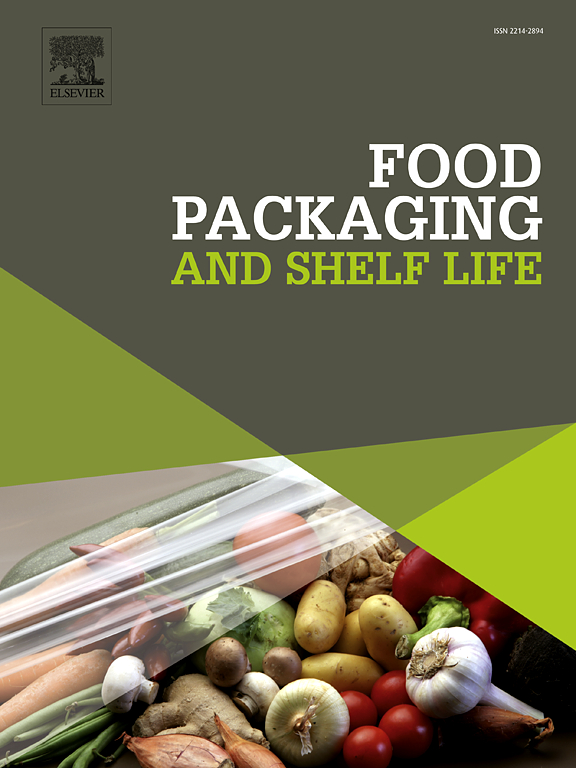Comparative study of preservation techniques for refrigerated Atlantic bonito Fillets: Effects of modified atmosphere packaging, vacuum packaging, and alginate coating on shelf life and quality
IF 10.6
1区 农林科学
Q1 FOOD SCIENCE & TECHNOLOGY
引用次数: 0
Abstract
Effective preservation strategies are essential to extend fish shelf life, minimize waste, and ensure product quality. Owing to its high perishability, fish is prone to rapid deterioration due to physicochemical changes and microbial growth. This study evaluated the effectiveness of vacuum packaging (50 % vacuum), modified atmosphere packaging (MAP: 80 % N₂ + 20 % CO₂), and sodium alginate coating (1 %), all under refrigeration, compared to refrigeration alone as a control. Atlantic bonito (Sarda sarda) fillets were stored at 4 °C for 15 days. Physicochemical parameters (moisture, pH, lipid and protein content, chloride, ash, and fibre), oxidative stability (peroxide index and TBARs), texture, colour, microbiological load, and sensory attributes were analysed at defined intervals. Among the treatments, MAP was most effective in preserving fillet quality, exhibiting the lowest peroxide (1.10 ± 0.05 mEq/kg) and TBARs values (1.29 ± 0.06 mg MDA/kg). MAP samples also demonstrated better retention of texture and colour and maintained microbial counts within acceptable regulatory limits throughout storage. Sensory evaluation confirmed superior freshness, texture, and aroma in MAP-treated fillets, closely resembling freshly processed fish. In contrast, samples stored under vacuum or with sodium alginate coating showed moderate improvements over refrigeration alone but were less effective than MAP. These findings highlight MAP as a promising packaging solution for extending the shelf life of Atlantic bonito, offering enhanced oxidative stability, microbial safety, and sensory quality. The results support the application of MAP in the fish industry to improve product stability and consumer acceptability during refrigerated storage.
大西洋鲣鱼片冷藏保存技术的比较研究:气调包装、真空包装和海藻酸盐涂层对保质期和质量的影响
有效的保存策略对于延长鱼类的保质期、减少浪费和确保产品质量至关重要。由于其高易腐性,鱼类容易因理化变化和微生物生长而迅速变质。本研究评估了真空包装(50% %真空)、改良气氛包装(MAP: 80 % N₂+ 20 % CO₂)和海藻酸钠涂层(1 %)在冷藏条件下的有效性,与单独冷藏作为对照进行了比较。大西洋鲣鱼(Sarda Sarda)鱼片在4°C保存15天。理化参数(水分、pH值、脂质和蛋白质含量、氯化物、灰分和纤维)、氧化稳定性(过氧化指数和TBARs)、质地、颜色、微生物负荷和感官属性在规定的时间间隔内进行分析。其中,MAP处理对鱼片质量保持效果最好,过氧化氢(1.10±0.05 mEq/kg)和TBARs值(1.29±0.06 mg MDA/kg)最低。MAP样品也表现出更好的质地和颜色保留,并在整个储存过程中将微生物数量保持在可接受的监管范围内。感官评价证实,map处理过的鱼片具有优越的新鲜度、质地和香气,与新鲜加工过的鱼非常相似。相比之下,在真空或海藻酸钠涂层下储存的样品比单独冷藏有适度的改善,但效果不如MAP。这些发现突出了MAP作为延长大西洋鲣鱼保质期的有前途的包装解决方案,提供增强的氧化稳定性,微生物安全性和感官质量。研究结果支持MAP在鱼类行业的应用,以提高产品在冷藏过程中的稳定性和消费者的接受度。
本文章由计算机程序翻译,如有差异,请以英文原文为准。
求助全文
约1分钟内获得全文
求助全文
来源期刊

Food Packaging and Shelf Life
Agricultural and Biological Sciences-Food Science
CiteScore
14.00
自引率
8.80%
发文量
214
审稿时长
70 days
期刊介绍:
Food packaging is crucial for preserving food integrity throughout the distribution chain. It safeguards against contamination by physical, chemical, and biological agents, ensuring the safety and quality of processed foods. The evolution of novel food packaging, including modified atmosphere and active packaging, has extended shelf life, enhancing convenience for consumers. Shelf life, the duration a perishable item remains suitable for sale, use, or consumption, is intricately linked with food packaging, emphasizing its role in maintaining product quality and safety.
 求助内容:
求助内容: 应助结果提醒方式:
应助结果提醒方式:


